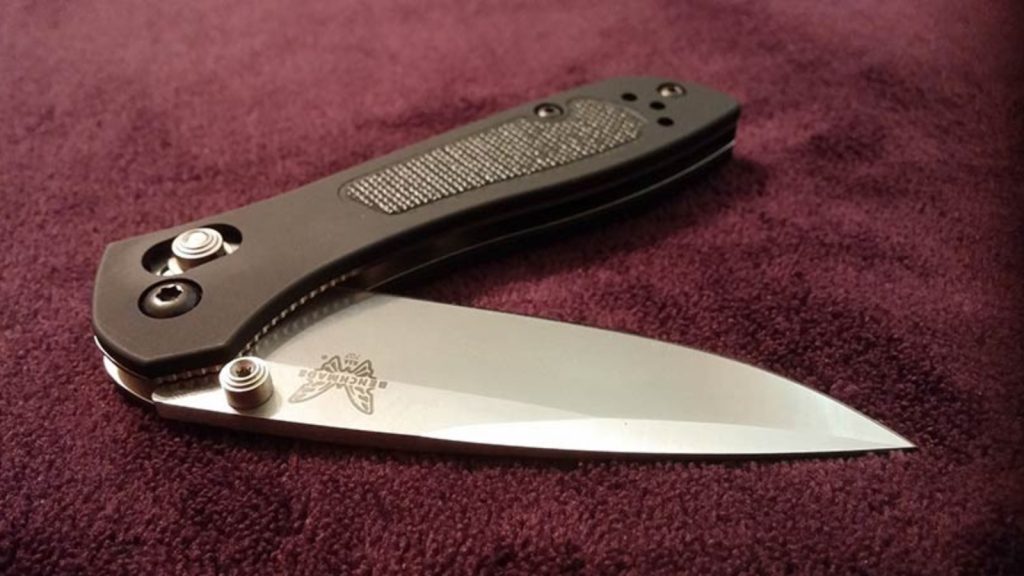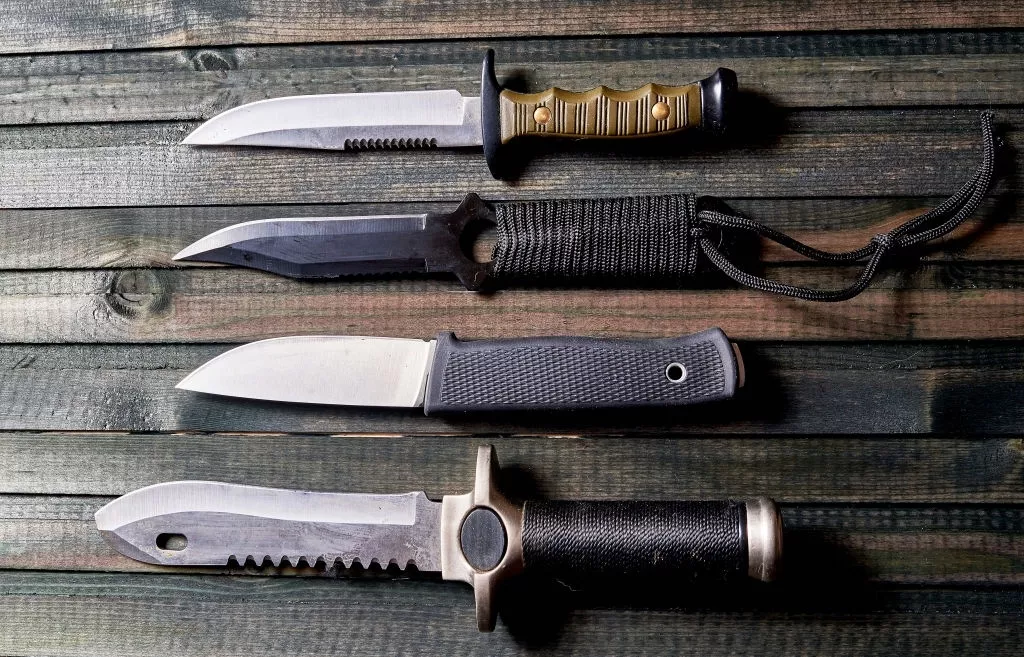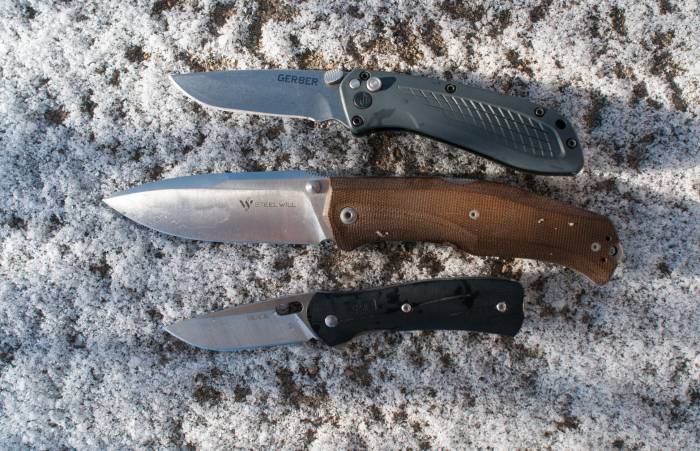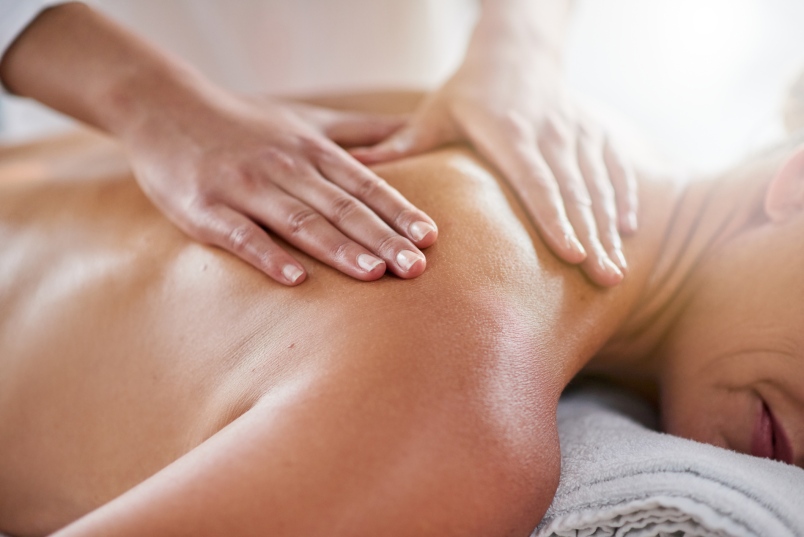Lock knives might be illegal in some places, but it depends on the rules in your area. In certain locations, they don’t allow lock knives because they worry that people might use them for bad things or hide them easily.
They want to ensure everyone stays safe, so they have rules about the types of knives people can have.
Lock knives, also called folding knives, are handy tools with a folding mechanism that tucks the blade into the handle when you’re not using it.
People like these knives because they’re easy to carry and good for everyday tasks, outdoor activities, and even self-defense. The folding part makes them easy to store and less likely to cause accidents.
Lock knives usually have a special lock that keeps the blade in place when it’s open. This lock makes sure the blade stays steady while you’re using it and won’t accidentally close.
It’s important to know that the rules about lock knives are different in different places. Laws can be different in various countries, states, or even cities.
They might have rules about things like how long the blade can be, what kind of lock the knife can have, or what the knife looks like.
Before you buy or carry a lock knife, you should check the laws where you live. Some places might not let you carry certain kinds of knives in public, while others might have rules about how big the knife can be.
Knowing the rules helps you use lock knives the right way and avoid getting into trouble.
Understanding Lock Knives

Definition and Features of Lock Knives:
Definition:
Lock knives, also known as folding knives, feature a mechanism to lock the blade in the open position, providing stability during use.
Features:
Folding Mechanism: Lock knives have a folding mechanism that allows the blade to be securely folded into the handle when not in use.
Variety of Designs: Lock knives come in various designs, including liner locks, frame locks, and other locking mechanisms.
Differentiating Between Legal and Illegal Lock Knives:
Legal Considerations:
Blade Length: Many jurisdictions have regulations regarding a folding knife’s maximum allowable blade length. It’s essential to be aware of and comply with these regulations.
Intended Use: Legal restrictions may also consider the knife’s intended use. Carrying a lock knife for self-defense purposes might be subject to different regulations than carrying it for utilitarian purposes.
Illegal Features:
Automatic Opening: In some places, knives with automatic opening mechanisms may be prohibited. Ensure your lock knife complies with local laws regarding opening mechanisms.
Concealed Weapons Laws: Some places may have specific laws regarding the concealment of knives. It’s crucial to understand these regulations to avoid legal issues.
Common Uses and Misconceptions About Lock Knives:
Common Uses:
Everyday Tasks: Lock knives are versatile tools commonly used for everyday tasks like cutting rope, opening packages, and food preparation.
Outdoor Activities: Many outdoor enthusiasts carry lock knives for activities such as camping, hiking, and fishing due to their portability and convenience.
Misconceptions:
Weaponization: One common misconception is that all lock knives are intended for self-defense. While some may serve that purpose, the majority are designed for practical, non-combative uses.
Illegal Automatically: Not all lock knives are illegal. Understanding the specific features and local regulations can help distinguish legal from illegal lock knives.
Understanding the definition, features, legal considerations, common uses, and misconceptions about lock knives is crucial for responsible ownership and compliance with local laws.
Local Laws and Regulations
Highlighting the Variability of Knife Laws by Jurisdiction:
Diverse Regulations:
Knife laws vary significantly from one jurisdiction to another, including differences at the national, state, and even municipal levels.
Legal considerations may include blade length, opening mechanisms, intended use, and concealed carry restrictions.
Global Differences:
Different countries have distinct approaches to regulating knives, influenced by cultural, historical, and safety factors.
Travelers should be aware of and adhere to the knife laws of the specific regions they visit to avoid legal complications.
Overview of Restrictions on Lock Knives in Specific Areas:
Blade Length Restrictions:
Some areas impose restrictions on the maximum allowable blade length for lock knives.
Opening Mechanisms:
You should know that certain ways of opening things, like automatic or assisted openings, might be against the rules in some places. You need to be aware of these restrictions to avoid getting into any legal trouble.
Intended Use Considerations:
The purpose for which a lock knife is carried may affect its legality. For example, carrying a knife for self-defense may be subject to different regulations than carrying it for everyday tasks.
Concealed Carry Laws:
Laws regarding the concealed carry of knives can vary. Some places may have strict regulations on carrying concealed knives, while others may allow it within certain limits.
How Local Laws Influence the Legality of Lock Knives:
Legal Definitions:
Understanding how local laws define and categorize lock knives is crucial. Legal definitions can vary; what might be considered a tool in one jurisdiction could be deemed a weapon in another.
Advocacy and Education:
Local communities and advocacy groups may work to influence or change knife laws. Staying informed and participating in educational initiatives can contribute to positive changes in legislation.
Periodic Reviews and Updates:
Knife laws may undergo changes and updates. Regularly checking for any revisions or amendments to local regulations ensures that individuals are aware of and comply with the latest legal requirements.
Concerns and Reasons for Restrictions
Addressing Potential for Criminal Use:
Weaponization:
Authorities may be concerned about the potential weaponization of lock knives for criminal purposes, including assaults or acts of violence.
Restrictions may aim to limit access to knives that could be easily misused in criminal activities.
Illegal Activities:
Criminal elements may use lock knives for illegal activities such as robbery or intimidation. Restrictions are implemented to deter and prevent the use of knives in the commission of crimes.
Public Safety:
Governments often enact restrictions to enhance public safety by minimizing the risk of knife-related crimes and the harm they can cause.
Discussing Concerns About Ease of Concealment:
Concealed Carry Dangers:
Lock knives, due to their foldable nature, can be easily concealed. Authorities may be concerned about individuals carrying hidden knives for nefarious purposes.
Restrictions on concealed carry aim to address these concerns and make it easier for law enforcement to identify potential threats.
Unseen Threats:
The ability to conceal a knife raises concerns about the potential for individuals to carry hidden weapons without detection, increasing the risk of surprise attacks and altercations.
Exploring Public Safety Considerations:
Accidental Injuries:
Authorities may restrict certain types of lock knives or features to prevent accidental injuries, especially among those unfamiliar with proper knife handling.
Ensuring that knives are used responsibly and safely is a key consideration in public safety regulations.
Crowded Spaces:
In crowded public spaces, concerns about accidental injuries or altercations may lead to restrictions on the size or type of knives allowed to be carried.
Law Enforcement Response:
Restrictions on lock knives may facilitate law enforcement efforts by providing clear guidelines on what types of knives are allowed, making it easier to identify potential threats and respond effectively.
In summary, concerns about criminal use, ease of concealment, and public safety considerations are key factors driving restrictions on lock knives.
Balancing the need for personal freedom with the imperative to ensure public safety is a complex challenge faced by lawmakers when crafting and enforcing knife regulations.
Case Studies
Examples of Regions with Strict Lock Knife Regulations:
United Kingdom:
The UK has stringent knife laws, including restrictions on carrying certain types of lock knives in public places.
The Criminal Justice Act 1988 and the Offensive Weapons Act 2019 brought in rules to deal with knife crime. They included prohibiting specific types of knives and imposing harsher penalties for related offenses.
Australia:
Different states in Australia have varying knife laws. In some regions, there are strict regulations on carrying knives in public, with limitations on blade length and types of knives.
New South Wales, for instance, has implemented laws to address knife-related violence, including restrictions on carrying knives without a valid reason.
Instances Where Legal Changes Were Implemented:
Canada – Bill C-22 (2021):
In Canada, Bill C-22, which came into effect in 2021, brought changes to the Criminal Code, including amendments to knife-related offenses.
The legislation aimed to provide more clarity and flexibility in distinguishing between knives intended for lawful and criminal purposes.
Texas, USA – HB 1935 (2017):
Texas House Bill 1935, effective September 2017, eliminated restrictions on carrying certain types of knives, including daggers, dirks, stilettos, and, most notably, Bowie knives.
The legislation reflected a shift toward reducing restrictions on knife ownership and carrying.
Comparisons of Knife Laws in Different Countries:
Japan:
Japan has strict regulations on the possession and carrying of knives. The possession of certain types of knives, especially those with a fixed blade, is heavily regulated.
There are specific exemptions for knives used for work or recreational activities, but carrying knives in public spaces without a valid reason is generally restricted.
Switzerland:
Switzerland has relatively liberal knife laws, with a focus on the responsible use of knives. Carrying knives in public is generally allowed, but there are restrictions on carrying knives with the intent to harm or threaten others.
Swiss laws highlight knife ownership’s cultural and practical aspects, recognizing the tool’s importance in various activities.
Germany:
Germany has specific regulations regarding the carry and possession of knives. Carrying knives in public is generally allowed, but there are restrictions on certain types of knives, such as switchblades and gravity knives.
German knife laws demonstrate a balance between allowing the practical use of knives and addressing potential safety concerns.
Legal changes reflect evolving societal attitudes, concerns about public safety, and efforts to strike a balance between individual freedoms and the prevention of criminal activities.
Understanding these examples provides insights into the complexities of crafting effective knife legislation.
Tips for Responsible Knife Ownership

Emphasizing the Importance of Understanding Local Laws:
Research Local Regulations:
Before purchasing or carrying a knife, thoroughly research and understand the local, state, and national laws governing knife ownership and carry.
Stay Informed:
Regularly check for updates or changes in knife laws in your area to ensure continued compliance with legal requirements.
Know the Definitions:
Familiarize yourself with the legal definitions of different types of knives and the criteria that may make a knife illegal in your jurisdiction.
Educating Individuals on Safe and Lawful Knife Use:
Safe Handling Practices:
Learn and practice safe knife-handling techniques to minimize the risk of accidents or injuries. This includes proper grip, cutting techniques, and storage.
Purposeful Use:
Use knives for their intended purposes, such as utility tasks, cooking, or outdoor activities. Avoid using knives in a manner that could be perceived as threatening or dangerous.
Avoiding Conflicts:
Be aware of the potential impact your knife may have on others. Avoid displaying or using knives in a way that may cause discomfort or fear in public spaces.
Encouraging Responsible Knife Ownership Practices:
Secure Storage:
Keep your knives safely stored when you’re not using them to avoid unauthorized access, especially if you have children or guests.
Regular Maintenance:
Keep your knives well-maintained by sharpening blades and checking locking mechanisms. Well-maintained knives are safer to use and less prone to accidents.
Legal Carry:
Carry knives in accordance with local laws. If there are restrictions on blade length or opening mechanisms, ensure your knife complies with these regulations.
Educate Others:
Share knowledge about responsible knife ownership with friends, family, and the community. Encourage others to be aware of and abide by local knife laws.
Participate in Community Initiatives:
Engage with community programs or initiatives that promote responsible knife ownership. Support efforts to educate the public on safe and lawful knife use.
Remember, responsible knife ownership involves complying with legal requirements and practicing safe and considerate knife use in various contexts.
FAQs
Are all lock knives illegal?
No, not all lock knives are illegal. The legality depends on specific characteristics and local regulations.
What makes a lock knife illegal?
Factors such as blade length, opening mechanism, and intended use can contribute to the illegality of a lock knife. Check local laws for details.
Are lock knives illegal everywhere?
No, legality varies by jurisdiction. Some places have strict regulations, while others may permit certain types of lock knives.
Can I carry a lock knife for self-defense?
Laws regarding carrying a locked knife for self-defense vary. It’s crucial to check local regulations, as some jurisdictions may have specific rules on carrying knives for protection.
What are the consequences of carrying an illegal lock knife?
Consequences may include criminal charges, fines, imprisonment, and confiscation of the knife, depending on the severity of the offense and local laws.
Can I carry a lock knife in my pocket?
Rules on carrying knives in pockets differ. Some places allow it within certain limits, while others may have strict regulations. Check local laws for guidance.
Are there age restrictions for owning a lock knife?
Age restrictions for owning a lock knife can vary. Some places may set a minimum age, and it’s essential to comply with these regulations.
Can I carry a lock knife for camping or outdoor activities?
Carrying a lock knife for camping or outdoor activities is often allowed, but the type of knife and its use must align with local regulations.
Do I need a permit to carry a lock knife?
In some jurisdictions, permits may be required to carry certain types of knives. Check local laws to determine if a permit is necessary.
Are there any exceptions to lock knife restrictions?
Some places may have exceptions for specific professions or activities that require the use of lock knives. Check local laws for any such exemptions.
Can I buy a lock knife online and have it shipped to my location?
Purchasing a lock knife online and having it shipped to your location may be subject to restrictions. Ensure that you comply with both the seller’s and your local laws before making a purchase.
Conclusion
If you’re into knives, knowing and following the rules in your area is crucial. You should always check the local laws and use your knife safely and for the right reasons. Keep it secure when not in use, and make sure it’s well-maintained.











